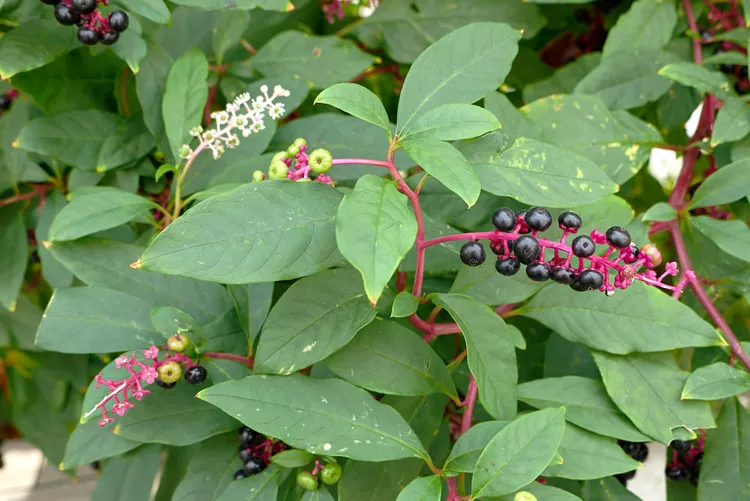How to Get Rid of Pokeweed in Your Yard

American pokeweed (Phytolacca americana) is a vigorous plant that can be tricky to get rid of. This perennial weed grows very fast and can reach 10 feet tall by three feet wide in a single season, crowding out other plants nearby. Although pokeweed is native to the eastern half of North America, it has spread to most parts of the U.S. and is considered invasive outside of its native range. But even where it’s native, you may not want this coarse, aggressive plant in your yard.
What Does Pokeweed Look Like?
Pokeweed, which is often found along roadsides, in disturbed fields, and woodlands, produces large, dark green leaves that are held on robust stems; and it can grow so big that it often looks like a shrub. Clusters of small, greenish white flowers emerge in early summer, followed by inky purple berries that have been used both as ink and as a dye.
Beware of Pokeweed Toxicity
All parts of the American pokeweed plant are poisonous—especially the roots. “If allowed to grow uninhibited, pokeweed develops a rather large and toxic root mass,” says Dwight Lingenfelter, Senior Extension Associate at Penn State University.
Although some folks eat both leaves (poke salad) and pokeweed berries, think twice before sampling them; they need to be harvested at certain times and to be prepared very cautiously, otherwise they can make you sick—or worse. And even if not ingested, the plant can cause a very nasty rash. So, for the safety of your family and pets, you should get rid of pokeweed in your yard, and keep it from coming back.
Getting Rid of Young Pokeweed
If you can identify pokeweed while it’s fairly young (before it’s had a chance to become established), weeding them out by hand is a good option, especially while the soil is damp. Your goal is to remove young plants with their root system intact.
“Hand pulling can be effective especially on newly germinated plants and/or plants that are in the first year of growth,” says Scott Oneto, University of California Cooperative Extension Farm Advisor. “Even though plants can get quite large in the first year, the large stems can aid in hand pulling as it allows for something to grab onto for extracting plants out of the soil. In the summer, when soils dry, it is more difficult to hand pull,“ says Oneto.
If you know that pokeweed has been growing in an area, keep your eyes peeled for seedlings that will arise from dropped fruit. “Pokeweed seedlings can emerge from seeds throughout the growing season so make sure to watch for them and control them when they are small and before they have a chance to get a large root system,” says Lingenfelter. And make sure to protect your skin from possible rash by wearing gardening gloves and long sleeves and pants while getting rid of pokeweed.
How to Kill Pokeweed That's Established
The larger the pokeweed plant, the more difficult it is to weed out by hand. Pulling on the stem may cause it to snap off. “Removing just the above ground portion of the plant (leaves and stems) will result in resprouting from the root crown,” says Oneto. He suggests using a shovel to dig out more established plants. But you will have to dig deeply to remove the entire root system, which can be extensive.
For large, well-rooted pokeweed plants, getting the entire root mass may not be possible. In this case, Oneto advises focusing on removing the top 3-6 inches of root from the soil surface. This will help minimize and reduce resprouting.
If pulling or digging are not sufficient to eliminate large pokeweed, you may need to resort to treating it with a weed killer. “Herbicides such as Roundup (glyphosate), 2,4-D, and dicamba can be used to provide control of the pokeweed but caution must be taken when using these products,” says Lingenfelter, who notes that desirable plants are easily injured or killed by accidental contact with these chemicals.
"Organic herbicides such as vinegar, oils from clove, cinnamon, lemongrass, etc, as well as other organic types will not provide effective control of pokeweed since they only ‘burn’ the foliage and do not translocate (travel) into the roots system,” says Lingenfelter. He suggests that late summer or early fall is the most effective time to apply the herbicide. He also notes that it may take more than one season to achieve effective control of established pokeweed.